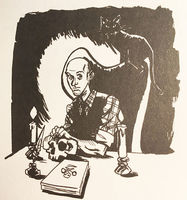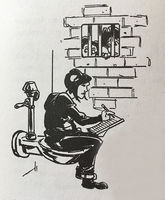The noir playing fields of YA
By Lisa de Nikolits
Today we'll leave the scotch-soaked detectives of noir at the bar and move on to the dark playing fields of YA! We have the great pleasure of chatting to the über-talented Evan Munday, author of The Dead Kid Detective Agency series and Dial M for Morna. Today’s quotes are from Loyalist to a Fault.
Lisa: Hi Evan! When you and I first discussed this post (YA noir), you said you weren’t entirely convinced that such a category exists and I agree with you! But I've always thought the concept itself (of a dead kid’s detective agency) as being rather noir.... dead kids rising from their graves on the night of the full moon... and this passage is quite noir:
“For the next hour and a half, the dead kids sat beside me and helped me frantically write my report. Around 5 a.m., they returned to the cemetery and shortly after that, I nodded off and napped on the cot in the far corner of the cell.”
Do you have any comments/challenges on my noirish insights into your work?
Evan: I’d be flattered if someone read my work as noirish. There are certainly noir elements to the book series – there’s a detective (though much younger than most noir detectives), there’s a low-key menace throughout the books and the town they’re set in: Sticksville. (Throughout the series, it’s suggested a secret society exists, getting up to all sorts of misdeeds.) In some ways, the setting is like a Blue Velvet or Twin Peaks lite.
But I wouldn’t categorize them as noir myself, as the element of the supernatural or the unexplained is not something we see all that much in noir, outside of small parts of movies that are on the border, like Cat People. Also, I feel like The Dead Kid Detective Agency, despite the title, is ultimately hopeful because the protagonist, October, remains hopeful. Despite the menace, I think the books are filled with optimism. I’ve always felt the books are more like written equivalents to Scooby-Doo. Is Scooby-Doo noir? Sort of, I guess.
Lisa: Do you think the concept of noir can morph and change? Much of the English language is constantly evolving, so do you think our interpretations of literature can change too?
Evan: Definitely I think it’s an evolving concept. As far as I know, it wasn’t a fiction genre first – it was a movie one. So even the idea of written noir is an evolution of the term. I feel like noir is more of a tonal thing rather than a checklist of criteria. The fact that things as divergent as the TV show Veronica Mars, the films Blade Runner and Tokyo Drifter, and the book Inherent Vice can all be easily argued as noir just demonstrates how the idea of noir is an ever-mutating one.
Lisa: Have you watched The Hotel Beau Sejour? It’s a Netflix series. My mom didn’t want to watch it because the girl had died – do people ever express reluctance to read your books (or let their kids read your books) because the kids are dead?
Evan: I hadn’t heard of this show before you asked about it, but I read the concept and love it, so it’s going to be the next thing I watch. Though I don’t really believe in ghosts, I am obsessed with them. One of my first creative writing assignments in university is very similar in premise to The Hotel Beau Sejour. In my short story, a ghost fell in love with a living woman, then slowly realized that she is the one who killed him.
Your CanLit News
Subscribe to Open Book’s newsletter to get local book events, literary content, writing tips, and more in your inbox
Some people find the concept of the series gruesome – and it is. (With a Google Alert open for ‘dead kid detective agency,’ I am delivered all sorts of tragedy to my inbox. But I’ve had more pushback about references to the occult, rather than the death of children. People seem more troubled by undead children than dead ones. And parents with kids reading my books grew up reading Christopher Pike, John Bellairs, and (later) R.L. Stine. I was reading Stephen King at ten. Kids’ books have always been morbid and filled with young people’s deaths. If your children haven’t traumatized by the macabre illustrations in the Scary Stories to Tell in the Dark series, they won’t be troubled by my books in the least.
Lisa: And while it is noir, the books are hilarious too:
“Why were all these dead boys so keen on dancing?”
Do you always write with a comedic slant? I must say, one of my fav parts of your book are the Appendices at the end, they are hilarious. It seems like you have a lot of fun writing them?
Evan: Yeah, if these books are noir, they’re noir in the way the Coen Brothers are noir. I would have a difficult time writing something completely straight. Maybe it’s a defense or coping mechanism, or maybe it’s the characters I’m drawn to – I am way more drawn to people who can see the absurdity of nearly everything in life.
As much as I admire creators who can sustain bleakness and despair, I can’t emulate that to save my life. I’ve tried and it just comes off as hollow – even worse than my usual writing! The Appendices, in which I try to describe pop culture concepts like Ke$ha or My Bloody Valentine (movie or band) in, like, two sentences, are by far the most fun things to write.
Lisa: You’re an illustrator, so do you see the story as a storyboard in your head before you actually write it? Does it start off as a graphic novel in a sense and then expand?
Evan: No. Though these books begin as scenes in my head (as I think they do for most writers), I don’t storyboard them first. The process is all text-based until a few drafts are done. At the most, I’ll draw maps of scene locations to keep the direction of action clear in my head, if the action sequence is particularly complicated. Eventually I add illustrations to the book once they’re nearly complete.
The one exception is before I started writing the first book, I made a series of sketches of all the main characters so I had a good sense of their appearances (and how to describe them). Strangely, there are a few characters I’ve never drawn, such as October’s dad. I’m sure there’s a psychological – maybe even noirish – reason behind that …
Lisa: In a way, I feel that most true graphic art is dark, it’s noir... Would you agree?
Evan: Not entirely. Certainly there’s a lot of graphic art that’s influence by noir, but it depends on what you’re defining as ‘true graphic art.’ There’s also a lot of very strong graphic art that doesn’t owe anything to noir.
In terms of comics, I think of things like Carl Barks’s classic Uncle Scrooge Comics. Or more recent comics like Lumberjanes or Shade the Changing Girl. I think you’d be hard-pressed to describe the art in those as noir. But if you’re talking about graphic art that uses lots of black and high-contrast shadow, then definitely. All that owes a great deal to noir.
Lisa: Have you seen Riverdale? It certainly took Archie and the gang to the darker side of noir! What did you think of the series?
Evan: I have seen all of Riverdale. As the co-host of one of the few Archie-themed podcasts, it was my duty to follow the series faithfully. (And, occasionally, discuss it with friends and podcast special guests.) Though I went into it with caution, I’m a total convert. I think it’s a really interesting adaption of Archie’s Pals and Gals that’s much campier and much smarter than people expected. And far more faithful to the tone and intent of the comics than people think. I’m really looking forward to the second season.
Lisa: Do we have a new Dead Kid Detective Agency book to look forward to or what’s next for you?
Evan: I’ve just completed a new draft of the fourth Dead Kid Detective Agency book, Connect the Scotts, which has been the most difficult one to write so far. For one, it’s a book that falls in the exact middle of the proposed seven-part series, so it has to do a lot of heavy lifting. For two, it looks at who killed Tabetha Scott, the character who escaped slavery in the southern U.S. via the Underground Railroad, so I wanted to make sure I accurately represented her story while not exploiting it, or participating in cultural appropriation, yet still (somehow) making it a relatively fun kids’ book. That balance is something that’s kept me up late more than a few nights.
Lisa: Thank you very much for being with us today!
https://www.inanna.ca/catalog/no-fury/
http://www.lisadenikolitswriter.com
https://49thshelf.com/Books/N/No-Fury-Like-That
https://49thshelf.com/Books/L/Loyalist-to-a-Fault2
The views expressed in the Writer-in-Residence blogs are those held by the authors and do not necessarily reflect the views of Open Book.
Originally from South Africa, Lisa de Nikolits has been a Canadian citizen since 2003. She has a Bachelor of Arts in English Literature and Philosophy and has lived in the U.S.A., Australia, and Britain. She is the author of seven acclaimed novels, including her most recent novel, No Fury Like That (Inanna Publications). She has won the IPPY Gold Medal for Women's Issues Fiction and was long-listed for the ReLit Award. Lisa has a short story in Postscripts To Darkness (2015), a short story in the anthology Thirteen O'Clock by the Mesdames of Mayhem, and flash fiction and a short story in the debut issue of Maud.Lin House.





